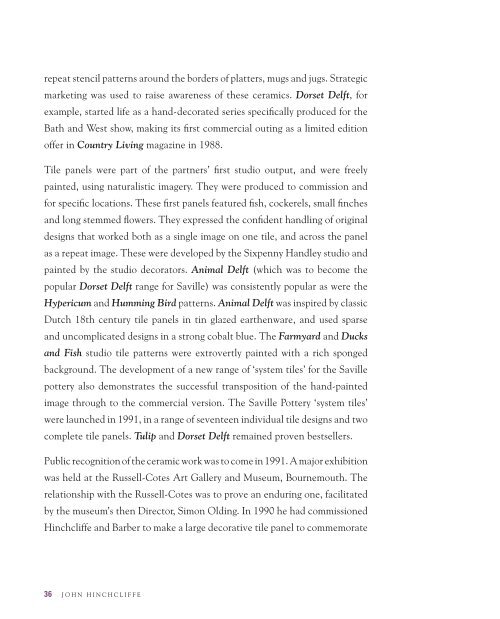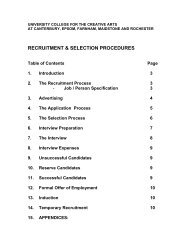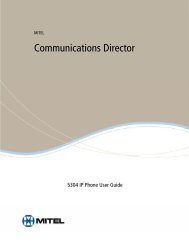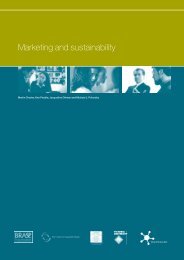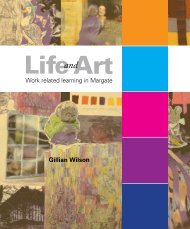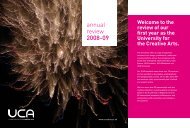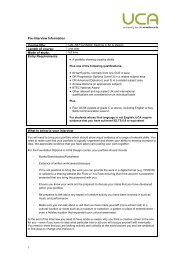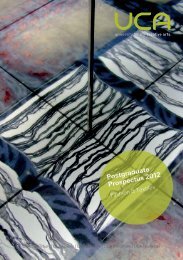John Hinchcliffe
John Hinchcliffe
John Hinchcliffe
- No tags were found...
You also want an ePaper? Increase the reach of your titles
YUMPU automatically turns print PDFs into web optimized ePapers that Google loves.
epeat stencil patterns around the borders of platters, mugs and jugs. Strategicmarketing was used to raise awareness of these ceramics. Dorset Delft, forexample, started life as a hand-decorated series specifically produced for theBath and West show, making its first commercial outing as a limited editionoffer in Country Living magazine in 1988.Tile panels were part of the partners’ first studio output, and were freelypainted, using naturalistic imagery. They were produced to commission andfor specific locations. These first panels featured fish, cockerels, small finchesand long stemmed flowers. They expressed the confident handling of originaldesigns that worked both as a single image on one tile, and across the panelas a repeat image. These were developed by the Sixpenny Handley studio andpainted by the studio decorators. Animal Delft (which was to become thepopular Dorset Delft range for Saville) was consistently popular as were theHypericum and Humming Bird patterns. Animal Delft was inspired by classicDutch 18th century tile panels in tin glazed earthenware, and used sparseand uncomplicated designs in a strong cobalt blue. The Farmyard and Ducksand Fish studio tile patterns were extrovertly painted with a rich spongedbackground. The development of a new range of ‘system tiles’ for the Savillepottery also demonstrates the successful transposition of the hand-paintedimage through to the commercial version. The Saville Pottery ‘system tiles’were launched in 1991, in a range of seventeen individual tile designs and twocomplete tile panels. Tulip and Dorset Delft remained proven bestsellers.Public recognition of the ceramic work was to come in 1991. A major exhibitionwas held at the Russell-Cotes Art Gallery and Museum, Bournemouth. Therelationship with the Russell-Cotes was to prove an enduring one, facilitatedby the museum’s then Director, Simon Olding. In 1990 he had commissioned<strong>Hinchcliffe</strong> and Barber to make a large decorative tile panel to commemoratethe opening of a new museum extension by the Mayor of Bournemouthand the then Minister for the Arts, Richard Luce MP. The panel showed adynamic arrangement of stencilled and hand-painted fish, alluding to themuseum’s seaside location, as well as the long tradition of public tile panelschampioned by the nearby Poole Pottery.The 1991 exhibition for the Russell-Cotes presented two new studio ranges thatwere later developed into commercially-produced wares. A highly-colouredseries of plates with birds were shown, painted by <strong>Hinchcliffe</strong>, and amongst hisbest ceramic work. Tropical finches, parrots and toucans were executed withcompelling rhythm, surrounded by vibrant yellow and green borders. These wereplates made for show, unusually, and not primarily for use. A range of black andwhite tablewares was also introduced. African animals such as zebras, giraffesand antelopes, as well as a swan and dolphin, were crisply painted in a deep greyblackwith a hatched border. The drawings vividly expressed movement. Theyowe something, perhaps, to <strong>Hinchcliffe</strong>’s interest in the Omega Workshops,and in particular marquetry furniture by both Duncan Grant and Roger Fry,which showed stylised patterns of African animals. 42A rare series of plates showed, for the first time, nude female figures, with apre-Raphaelite abundance of hair sketched in dramatic, simple strokes of greyblackglaze. <strong>Hinchcliffe</strong> used the exhibition to demonstrate his skill as a painteras well as a ceramic designer. The new ranges for the Russell-Cotes exhibitionrecalled their early enthusiasm for studio production and the production ofhand-painted limited editions. The freedom and painterly effectiveness of theseworks contrasted with the demands of the studio, where there was an increasingemphasis on monitoring standards. Perhaps <strong>Hinchcliffe</strong> and Barber wanted to finda way of recapturing freedom and creativity. They were to seek this freedom bysetting up a third studio, and transferring their home and workshop to France.36 J o h n H i n c h c l i f f e J o h n H i n c h c l i f f e 37


